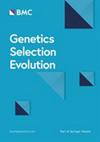由于标记和QTL之间的长距离关联,估计的基因组育种值随着世代的变化而下降
IF 3.1
1区 农林科学
Q1 AGRICULTURE, DAIRY & ANIMAL SCIENCE
引用次数: 0
摘要
大多数候选基因评估的验证研究(在观察表型之前)存在其预测育种值的膨胀,即其后期观察到的表型对早期预测的回归系数小于1。本研究的目的是表明这种膨胀模式至少部分反映了参考群体中标记和数量性状位点(QTL)之间的长距离关联,并提出了估算相应“侵蚀”系数的方法。在不同的奶牛品种中观察到跨染色体连锁不平衡(LD),这是有限的有效群体规模和参考群体内部关系的结果。由于这种长距离LD,估计的SNP效应捕获了远端qtl的非零贡献,其中一些位于其他染色体上,而不是SNP本身。因此,相应的SNP效应在下一代中部分丢失,我们将这种丢失称为“侵蚀”。根据混合模型方程推导出的QTL对SNP效应贡献的概念,我们通过模拟表明,这一长期LD解释了估计基因组育种值方差的6-25%,当评估模型包括残余多基因效应时,这一比例不变。假设已知的模拟QTL效应,提出了两种预测侵蚀因子的方法。在方法1中,从参考群体中模拟一代后代,根据新模拟一代中估计的SNP效应对这些后代的GEBV进行回归,基于参考群体中估计的SNP效应对同一后代的GEBV进行回归。在方法2中,根据SNP-QTL重组率对所有对SNP效应的QTL贡献进行回归,并求和以预测下一代的GEBV。基于侵蚀对原始GEBV贡献的GEBV回归系数也是对侵蚀的估计。以2021年法国诺曼底雌性参考牛种群为例,显示侵蚀因子范围为0.84至0.87。考虑侵蚀对于避免通胀和有偏见的预测很重要。讨论了在预测中减少通货膨胀和修正通货膨胀的方法。本文章由计算机程序翻译,如有差异,请以英文原文为准。
Erosion of estimated genomic breeding values with generations is due to long distance associations between markers and QTL
Most validation studies of genomic evaluations on candidates (prior to observing phenotypes) present inflation of their predicted breeding values, i.e., regression coefficients of their later observed phenotypes on the early predictions are smaller than one. The aim of this study was to show that this inflation pattern reflects at least partly long-distance associations between markers and quantitative trait loci (QTL) in the reference population and to propose methods to estimate the corresponding “erosion” coefficient. Across-chromosome linkage disequilibrium (LD) is observed in different dairy cattle breeds, being a result from limited effective population size and from relationships within the reference population. Due to this long distance LD, the estimated SNP effects capture non-zero contributions from distant QTLs, some located on other chromosomes than the SNP itself. Therefore, corresponding SNP effects are partly lost in the next generations and we refer to this loss as “erosion”. With the concept of QTL contribution to SNP effects derived from mixed model equations, we show with simulation that this long range LD explains 6–25% of the variance of the estimated genomic breeding values, a proportion that is unchanged when the evaluation model includes a residual polygenic effect. Two methods are proposed to predict this erosion factor assuming known simulated QTL effects. In Method 1, one generation of progeny is simulated from the reference population and the GEBV of these progeny based on SNP effects estimated in this newly simulated generation are regressed on the GEBV of the same progeny based on SNP effects estimated in the reference population. In Method 2 all the QTL contributions to SNP effects are regressed based on SNP-QTL recombination rates and summed to predict the GEBV at the next generation. The regression coefficient of the GEBV based on eroded contributions on the raw GEBV is also an estimate of erosion. An illustration is given with the French Normande female reference bovine population in 2021, showing erosion factors ranging from 0.84 to 0.87. Accounting for erosion is important to avoid inflation and biased predictions. The ways to both reduce inflation and to correct for it in the prediction are discussed.
求助全文
通过发布文献求助,成功后即可免费获取论文全文。
去求助
来源期刊

Genetics Selection Evolution
生物-奶制品与动物科学
CiteScore
6.50
自引率
9.80%
发文量
74
审稿时长
1 months
期刊介绍:
Genetics Selection Evolution invites basic, applied and methodological content that will aid the current understanding and the utilization of genetic variability in domestic animal species. Although the focus is on domestic animal species, research on other species is invited if it contributes to the understanding of the use of genetic variability in domestic animals. Genetics Selection Evolution publishes results from all levels of study, from the gene to the quantitative trait, from the individual to the population, the breed or the species. Contributions concerning both the biological approach, from molecular genetics to quantitative genetics, as well as the mathematical approach, from population genetics to statistics, are welcome. Specific areas of interest include but are not limited to: gene and QTL identification, mapping and characterization, analysis of new phenotypes, high-throughput SNP data analysis, functional genomics, cytogenetics, genetic diversity of populations and breeds, genetic evaluation, applied and experimental selection, genomic selection, selection efficiency, and statistical methodology for the genetic analysis of phenotypes with quantitative and mixed inheritance.
 求助内容:
求助内容: 应助结果提醒方式:
应助结果提醒方式:


